2023年高三高考英语外刊阅读理解训练——自动驾驶技术? ——改编自driverless cars(含解析)
文档属性
| 名称 | 2023年高三高考英语外刊阅读理解训练——自动驾驶技术? ——改编自driverless cars(含解析) | 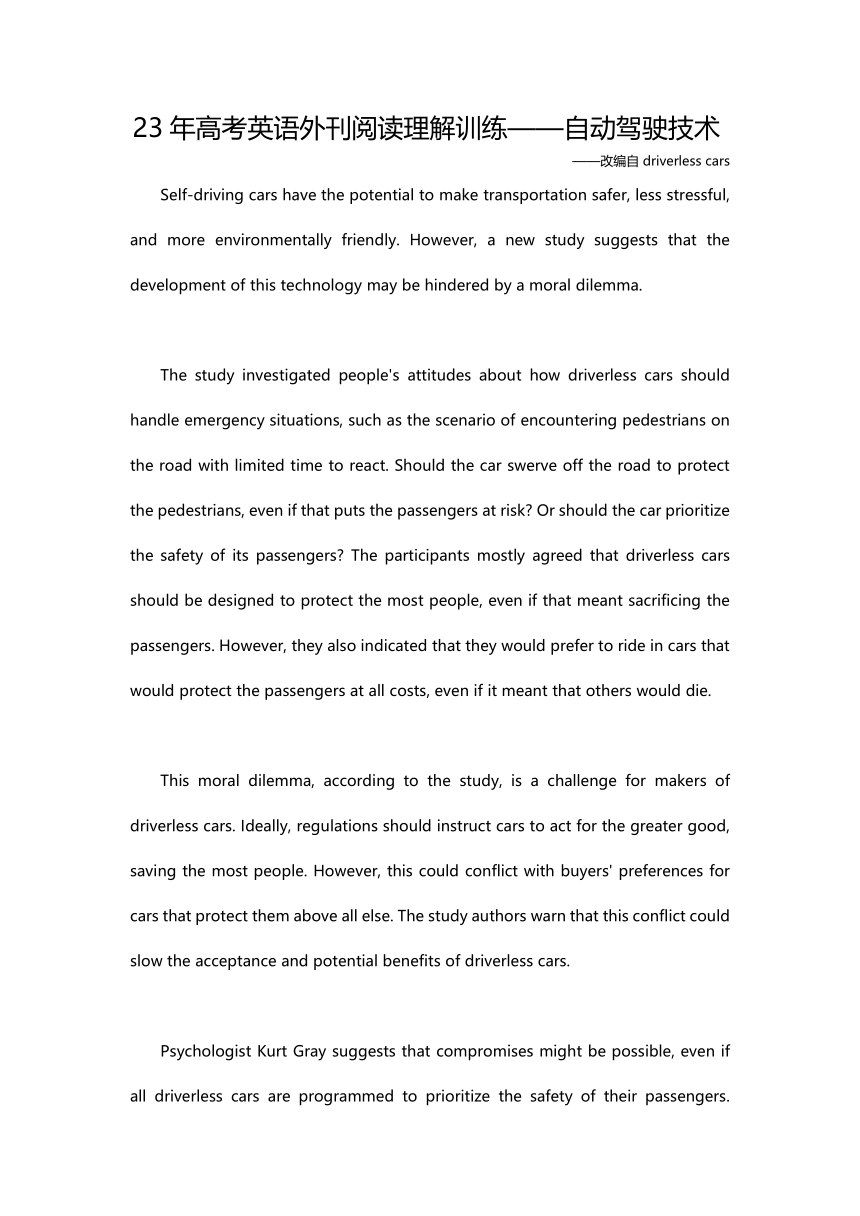 | |
| 格式 | docx | ||
| 文件大小 | 20.5KB | ||
| 资源类型 | 教案 | ||
| 版本资源 | 通用版 | ||
| 科目 | 英语 | ||
| 更新时间 | 2023-05-15 09:44:21 | ||
图片预览

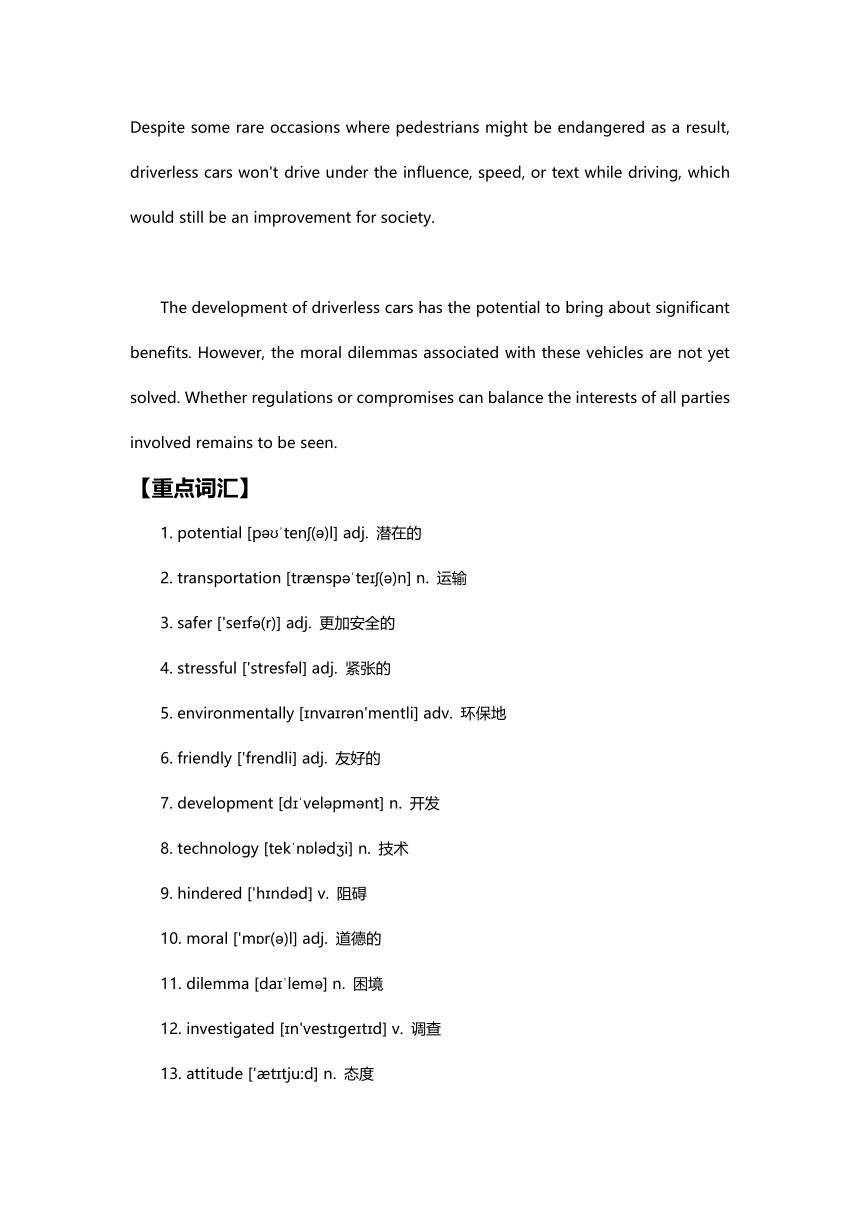
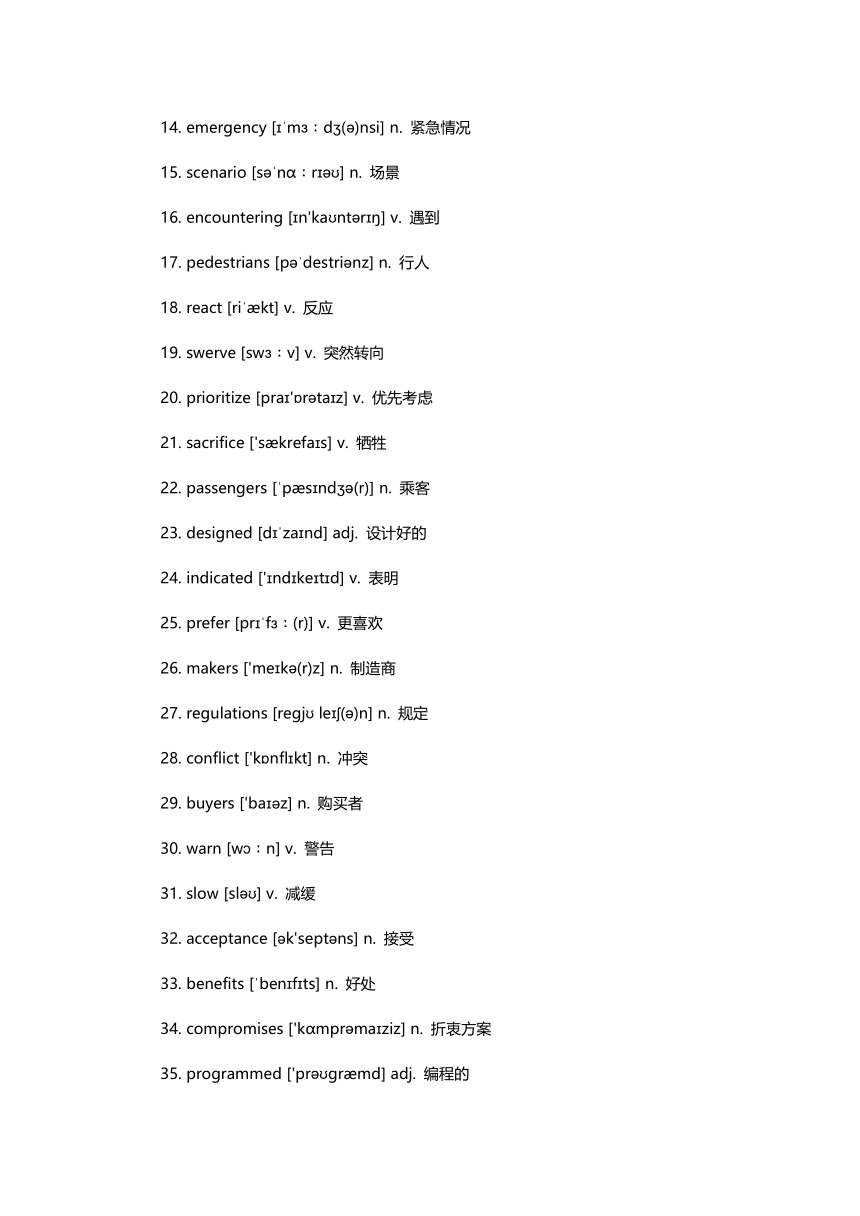
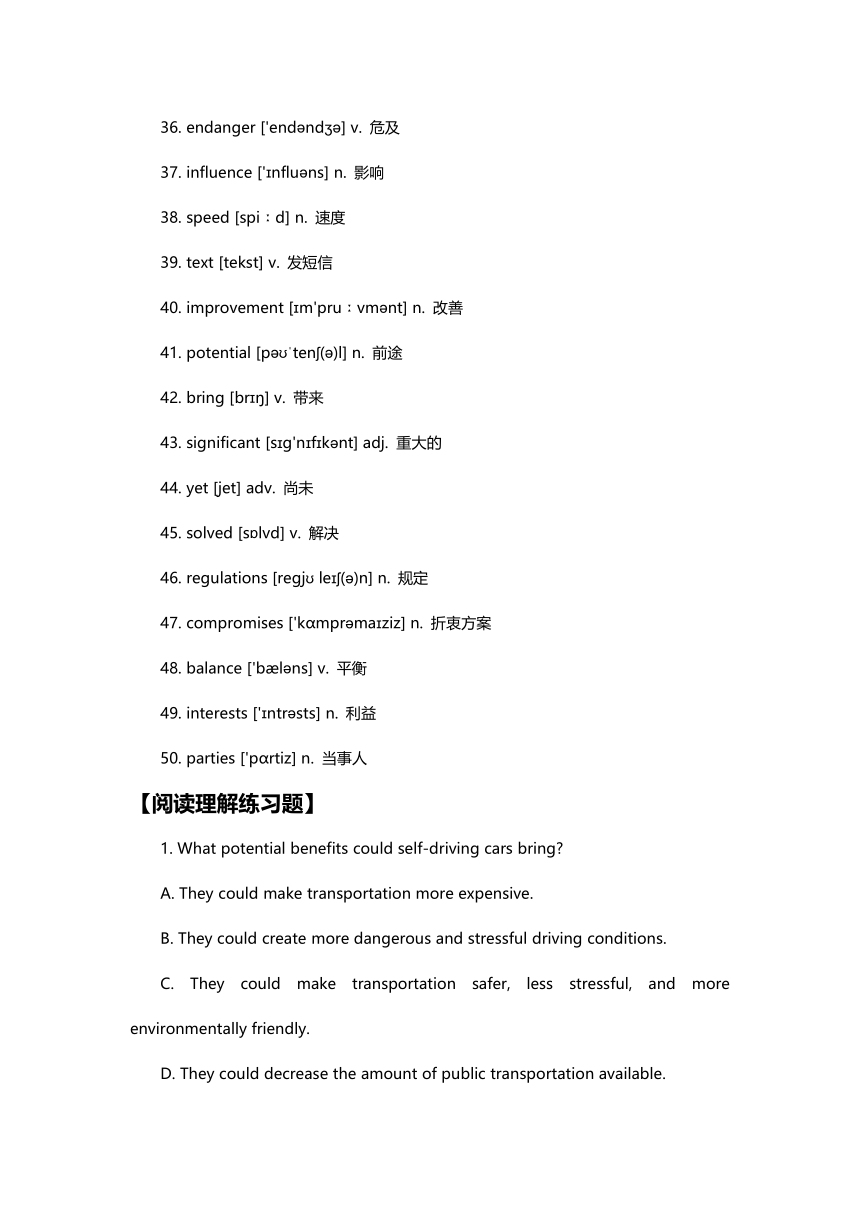
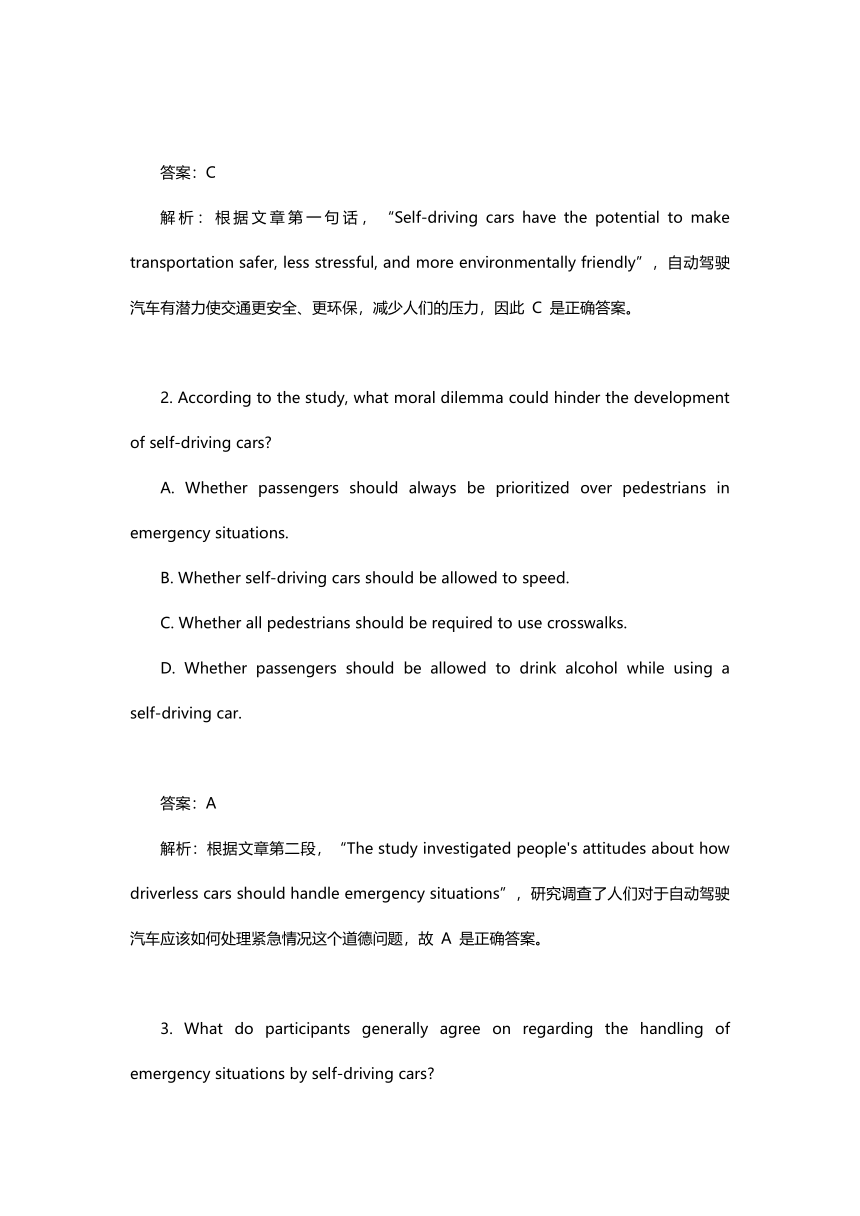
文档简介
23年高考英语外刊阅读理解训练——自动驾驶技术
——改编自driverless cars
Self-driving cars have the potential to make transportation safer, less stressful, and more environmentally friendly. However, a new study suggests that the development of this technology may be hindered by a moral dilemma.
The study investigated people's attitudes about how driverless cars should handle emergency situations, such as the scenario of encountering pedestrians on the road with limited time to react. Should the car swerve off the road to protect the pedestrians, even if that puts the passengers at risk Or should the car prioritize the safety of its passengers The participants mostly agreed that driverless cars should be designed to protect the most people, even if that meant sacrificing the passengers. However, they also indicated that they would prefer to ride in cars that would protect the passengers at all costs, even if it meant that others would die.
This moral dilemma, according to the study, is a challenge for makers of driverless cars. Ideally, regulations should instruct cars to act for the greater good, saving the most people. However, this could conflict with buyers' preferences for cars that protect them above all else. The study authors warn that this conflict could slow the acceptance and potential benefits of driverless cars.
Psychologist Kurt Gray suggests that compromises might be possible, even if all driverless cars are programmed to prioritize the safety of their passengers. Despite some rare occasions where pedestrians might be endangered as a result, driverless cars won't drive under the influence, speed, or text while driving, which would still be an improvement for society.
The development of driverless cars has the potential to bring about significant benefits. However, the moral dilemmas associated with these vehicles are not yet solved. Whether regulations or compromises can balance the interests of all parties involved remains to be seen.
【重点词汇】
1. potential [p ten ( )l] adj. 潜在的
2. transportation [tr nsp te ( )n] n. 运输
3. safer ['se f (r)] adj. 更加安全的
4. stressful ['stresf l] adj. 紧张的
5. environmentally [ nva r n'mentli] adv. 环保地
6. friendly ['frendli] adj. 友好的
7. development [d vel pm nt] n. 开发
8. technology [tek n l d i] n. 技术
9. hindered ['h nd d] v. 阻碍
10. moral ['m r( )l] adj. 道德的
11. dilemma [da lem ] n. 困境
12. investigated [ n'vest ɡe t d] v. 调查
13. attitude [' t tju:d] n. 态度
14. emergency [ m d ( )nsi] n. 紧急情况
15. scenario [s nɑ r ] n. 场景
16. encountering [ n'ka nt r ] v. 遇到
17. pedestrians [p destri nz] n. 行人
18. react [ri kt] v. 反应
19. swerve [sw v] v. 突然转向
20. prioritize [pra ' r ta z] v. 优先考虑
21. sacrifice ['s krefa s] v. 牺牲
22. passengers [ p s nd (r)] n. 乘客
23. designed [d za nd] adj. 设计好的
24. indicated [' nd ke t d] v. 表明
25. prefer [pr f (r)] v. 更喜欢
26. makers ['me k (r)z] n. 制造商
27. regulations [regj le ( )n] n. 规定
28. conflict ['k nfl kt] n. 冲突
29. buyers ['ba z] n. 购买者
30. warn [w n] v. 警告
31. slow [sl ] v. 减缓
32. acceptance [ k'sept ns] n. 接受
33. benefits [ ben f ts] n. 好处
promises ['kɑmpr ma ziz] n. 折衷方案
35. programmed ['pr ɡr md] adj. 编程的
36. endanger ['end nd ] v. 危及
37. influence [' nflu ns] n. 影响
38. speed [spi d] n. 速度
39. text [tekst] v. 发短信
40. improvement [ m'pru vm nt] n. 改善
41. potential [p ten ( )l] n. 前途
42. bring [br ] v. 带来
43. significant [s ɡ'n f k nt] adj. 重大的
44. yet [jet] adv. 尚未
45. solved [s lvd] v. 解决
46. regulations [regj le ( )n] n. 规定
promises ['kɑmpr ma ziz] n. 折衷方案
48. balance ['b l ns] v. 平衡
49. interests [' ntr sts] n. 利益
50. parties ['pɑrtiz] n. 当事人
【阅读理解练习题】
1. What potential benefits could self-driving cars bring
A. They could make transportation more expensive.
B. They could create more dangerous and stressful driving conditions.
C. They could make transportation safer, less stressful, and more environmentally friendly.
D. They could decrease the amount of public transportation available.
答案:C
解析:根据文章第一句话,“Self-driving cars have the potential to make transportation safer, less stressful, and more environmentally friendly”,自动驾驶汽车有潜力使交通更安全、更环保,减少人们的压力,因此 C 是正确答案。
2. According to the study, what moral dilemma could hinder the development of self-driving cars
A. Whether passengers should always be prioritized over pedestrians in emergency situations.
B. Whether self-driving cars should be allowed to speed.
C. Whether all pedestrians should be required to use crosswalks.
D. Whether passengers should be allowed to drink alcohol while using a self-driving car.
答案:A
解析:根据文章第二段,“The study investigated people's attitudes about how driverless cars should handle emergency situations”,研究调查了人们对于自动驾驶汽车应该如何处理紧急情况这个道德问题,故 A 是正确答案。
3. What do participants generally agree on regarding the handling of emergency situations by self-driving cars
A. The car should prioritize the safety of its passengers over anything else.
B. The car should always swerve off the road to protect pedestrians.
C. The car should try to save as many people as possible in an emergency situation.
D. The car should immediately switch into manual mode in all emergency situations.
答案:C
解析:根据文章第二段,“The participants mostly agreed that driverless cars should be designed to protect the most people, even if that meant sacrificing the passengers” ,参与者普遍认为自动驾驶汽车应该设计成能保护最多的人,即使这意味着牺牲乘客,故 C 是正确答案。
4. What did the study reveal about participants' preferences for their own safety
A. They preferred cars that prioritize the safety of pedestrians over their own safety.
B. They preferred cars that prioritize the safety of their passengers over the safety of others.
C. They were indifferent to whether self-driving cars protected pedestrians or their passengers.
D. They believed that all self-driving cars should behave in the same manner regardless of who was at risk.
答案:B
解析: 根据文章第二段,“However, they also indicated that they would prefer to ride in cars that would protect the passengers at all costs, even if it meant that others would die”, 然而,他们也表示更愿意乘坐那些不惜任何代价保护乘客安全的车辆,即使这意味着其他人会死亡,故 B 是正确答案。
5. According to the study authors, what could slow the acceptance and potential benefits of self-driving cars
A. The high cost of self-driving car technology.
B. A lack of regulations governing the use of self-driving cars.
C. The moral dilemma associated with how self-driving cars handle emergency situations.
D. A lack of available infrastructure for self-driving cars.
答案:C
解析:根据文章第三段,“The study authors warn that this conflict could slow the acceptance and potential benefits of driverless cars”,研究作者警告该冲突可能会减缓自动驾驶汽车的接受程度和潜在利益,因此 C 是正确答案。
6. What suggestion did psychologist Kurt Gray have for resolving the moral dilemma presented by self-driving cars
A. All self-driving cars should be programmed to prioritize the safety of pedestrians over their passengers.
B. Drivers should still manually control their cars in emergency situations.
C. All self-driving cars should be programmed to prioritize the safety of passengers over others.
D. Society should decide which groups receive priority in emergency situations.
答案:C
解析:根据文章第四段,“Psychologist Kurt Gray suggests that compromises might be possible, even if all driverless cars are programmed to prioritize the safety of their passengers” ,心理学家 Kurt Gray 建议一个妥协方法可以是让所有的自动驾驶汽车都被编程成优先考虑乘客的安全,因此 C 是正确答案。
【全文逐句对照翻译】
自动驾驶汽车有可能使交通更安全、压力更小、更环保。
Self-driving cars have the potential to make transportation safer, less stressful, and more environmentally friendly.
然而,一项新的研究表明,这项技术的发展可能会受到道德困境的阻碍。
However, a new study suggests that the development of this technology may be hindered by a moral dilemma.
这项研究调查了人们对无人驾驶汽车应该如何处理紧急情况的态度,比如在路上遇到行人,时间有限的情况下做出反应。
The study investigated people's attitudes about how driverless cars should handle emergency situations, such as the scenario of encountering pedestrians on the road with limited time to react.
汽车是否应该急转弯以保护行人,即使这会使乘客处于危险之中
Should the car swerve off the road to protect the pedestrians, even if that puts the passengers at risk
还是说汽车应该优先考虑乘客的安全
Or should the car prioritize the safety of its passengers
与会者大多同意,无人驾驶汽车的设计应该保护大多数人,即使这意味着牺牲乘客。
The participants mostly agreed that driverless cars should be designed to protect the most people, even if that meant sacrificing the passengers.
然而,他们也表示,他们更愿意乘坐不惜一切代价保护乘客的汽车,即使这意味着其他人会死。
However, they also indicated that they would prefer to ride in cars that would protect the passengers at all costs, even if it meant that others would die.
根据这项研究,这种道德困境对无人驾驶汽车制造商来说是一个挑战。
This moral dilemma, according to the study, is a challenge for makers of driverless cars.
理想情况下,法规应该指导汽车为更大的利益而行动,拯救大多数人。
Ideally, regulations should instruct cars to act for the greater good, saving the most people.
然而,这可能会与买家对保护他们的汽车的偏好相冲突。
However, this could conflict with buyers' preferences for cars that protect them above all else.
该研究的作者警告说,这种冲突可能会减缓无人驾驶汽车的接受程度和潜在好处。
The study authors warn that this conflict could slow the acceptance and potential benefits of driverless cars.
心理学家库尔特·格雷(Kurt Gray)认为,即使所有的无人驾驶汽车都被编程为优先考虑乘客的安全,妥协也是可能的。
Psychologist Kurt Gray suggests that compromises might be possible, even if all driverless cars are programmed to prioritize the safety of their passengers.
尽管在一些罕见的情况下,行人可能会因此受到威胁,但无人驾驶汽车不会在酒后驾车、超速驾驶或边开车边发短信,这对社会来说仍然是一种进步。
Despite some rare occasions where pedestrians might be endangered as a result, driverless cars won't drive under the influence, speed, or text while driving, which would still be an improvement for society.
无人驾驶汽车的发展有可能带来巨大的好处。
The development of driverless cars has the potential to bring about significant benefits.
然而,与这些交通工具相关的道德困境尚未得到解决。
However, the moral dilemmas associated with these vehicles are not yet solved.
监管或妥协能否平衡各方利益还有待观察。
Whether regulations or compromises can balance the interests of all parties involved remains to be seen.
——改编自driverless cars
Self-driving cars have the potential to make transportation safer, less stressful, and more environmentally friendly. However, a new study suggests that the development of this technology may be hindered by a moral dilemma.
The study investigated people's attitudes about how driverless cars should handle emergency situations, such as the scenario of encountering pedestrians on the road with limited time to react. Should the car swerve off the road to protect the pedestrians, even if that puts the passengers at risk Or should the car prioritize the safety of its passengers The participants mostly agreed that driverless cars should be designed to protect the most people, even if that meant sacrificing the passengers. However, they also indicated that they would prefer to ride in cars that would protect the passengers at all costs, even if it meant that others would die.
This moral dilemma, according to the study, is a challenge for makers of driverless cars. Ideally, regulations should instruct cars to act for the greater good, saving the most people. However, this could conflict with buyers' preferences for cars that protect them above all else. The study authors warn that this conflict could slow the acceptance and potential benefits of driverless cars.
Psychologist Kurt Gray suggests that compromises might be possible, even if all driverless cars are programmed to prioritize the safety of their passengers. Despite some rare occasions where pedestrians might be endangered as a result, driverless cars won't drive under the influence, speed, or text while driving, which would still be an improvement for society.
The development of driverless cars has the potential to bring about significant benefits. However, the moral dilemmas associated with these vehicles are not yet solved. Whether regulations or compromises can balance the interests of all parties involved remains to be seen.
【重点词汇】
1. potential [p ten ( )l] adj. 潜在的
2. transportation [tr nsp te ( )n] n. 运输
3. safer ['se f (r)] adj. 更加安全的
4. stressful ['stresf l] adj. 紧张的
5. environmentally [ nva r n'mentli] adv. 环保地
6. friendly ['frendli] adj. 友好的
7. development [d vel pm nt] n. 开发
8. technology [tek n l d i] n. 技术
9. hindered ['h nd d] v. 阻碍
10. moral ['m r( )l] adj. 道德的
11. dilemma [da lem ] n. 困境
12. investigated [ n'vest ɡe t d] v. 调查
13. attitude [' t tju:d] n. 态度
14. emergency [ m d ( )nsi] n. 紧急情况
15. scenario [s nɑ r ] n. 场景
16. encountering [ n'ka nt r ] v. 遇到
17. pedestrians [p destri nz] n. 行人
18. react [ri kt] v. 反应
19. swerve [sw v] v. 突然转向
20. prioritize [pra ' r ta z] v. 优先考虑
21. sacrifice ['s krefa s] v. 牺牲
22. passengers [ p s nd (r)] n. 乘客
23. designed [d za nd] adj. 设计好的
24. indicated [' nd ke t d] v. 表明
25. prefer [pr f (r)] v. 更喜欢
26. makers ['me k (r)z] n. 制造商
27. regulations [regj le ( )n] n. 规定
28. conflict ['k nfl kt] n. 冲突
29. buyers ['ba z] n. 购买者
30. warn [w n] v. 警告
31. slow [sl ] v. 减缓
32. acceptance [ k'sept ns] n. 接受
33. benefits [ ben f ts] n. 好处
promises ['kɑmpr ma ziz] n. 折衷方案
35. programmed ['pr ɡr md] adj. 编程的
36. endanger ['end nd ] v. 危及
37. influence [' nflu ns] n. 影响
38. speed [spi d] n. 速度
39. text [tekst] v. 发短信
40. improvement [ m'pru vm nt] n. 改善
41. potential [p ten ( )l] n. 前途
42. bring [br ] v. 带来
43. significant [s ɡ'n f k nt] adj. 重大的
44. yet [jet] adv. 尚未
45. solved [s lvd] v. 解决
46. regulations [regj le ( )n] n. 规定
promises ['kɑmpr ma ziz] n. 折衷方案
48. balance ['b l ns] v. 平衡
49. interests [' ntr sts] n. 利益
50. parties ['pɑrtiz] n. 当事人
【阅读理解练习题】
1. What potential benefits could self-driving cars bring
A. They could make transportation more expensive.
B. They could create more dangerous and stressful driving conditions.
C. They could make transportation safer, less stressful, and more environmentally friendly.
D. They could decrease the amount of public transportation available.
答案:C
解析:根据文章第一句话,“Self-driving cars have the potential to make transportation safer, less stressful, and more environmentally friendly”,自动驾驶汽车有潜力使交通更安全、更环保,减少人们的压力,因此 C 是正确答案。
2. According to the study, what moral dilemma could hinder the development of self-driving cars
A. Whether passengers should always be prioritized over pedestrians in emergency situations.
B. Whether self-driving cars should be allowed to speed.
C. Whether all pedestrians should be required to use crosswalks.
D. Whether passengers should be allowed to drink alcohol while using a self-driving car.
答案:A
解析:根据文章第二段,“The study investigated people's attitudes about how driverless cars should handle emergency situations”,研究调查了人们对于自动驾驶汽车应该如何处理紧急情况这个道德问题,故 A 是正确答案。
3. What do participants generally agree on regarding the handling of emergency situations by self-driving cars
A. The car should prioritize the safety of its passengers over anything else.
B. The car should always swerve off the road to protect pedestrians.
C. The car should try to save as many people as possible in an emergency situation.
D. The car should immediately switch into manual mode in all emergency situations.
答案:C
解析:根据文章第二段,“The participants mostly agreed that driverless cars should be designed to protect the most people, even if that meant sacrificing the passengers” ,参与者普遍认为自动驾驶汽车应该设计成能保护最多的人,即使这意味着牺牲乘客,故 C 是正确答案。
4. What did the study reveal about participants' preferences for their own safety
A. They preferred cars that prioritize the safety of pedestrians over their own safety.
B. They preferred cars that prioritize the safety of their passengers over the safety of others.
C. They were indifferent to whether self-driving cars protected pedestrians or their passengers.
D. They believed that all self-driving cars should behave in the same manner regardless of who was at risk.
答案:B
解析: 根据文章第二段,“However, they also indicated that they would prefer to ride in cars that would protect the passengers at all costs, even if it meant that others would die”, 然而,他们也表示更愿意乘坐那些不惜任何代价保护乘客安全的车辆,即使这意味着其他人会死亡,故 B 是正确答案。
5. According to the study authors, what could slow the acceptance and potential benefits of self-driving cars
A. The high cost of self-driving car technology.
B. A lack of regulations governing the use of self-driving cars.
C. The moral dilemma associated with how self-driving cars handle emergency situations.
D. A lack of available infrastructure for self-driving cars.
答案:C
解析:根据文章第三段,“The study authors warn that this conflict could slow the acceptance and potential benefits of driverless cars”,研究作者警告该冲突可能会减缓自动驾驶汽车的接受程度和潜在利益,因此 C 是正确答案。
6. What suggestion did psychologist Kurt Gray have for resolving the moral dilemma presented by self-driving cars
A. All self-driving cars should be programmed to prioritize the safety of pedestrians over their passengers.
B. Drivers should still manually control their cars in emergency situations.
C. All self-driving cars should be programmed to prioritize the safety of passengers over others.
D. Society should decide which groups receive priority in emergency situations.
答案:C
解析:根据文章第四段,“Psychologist Kurt Gray suggests that compromises might be possible, even if all driverless cars are programmed to prioritize the safety of their passengers” ,心理学家 Kurt Gray 建议一个妥协方法可以是让所有的自动驾驶汽车都被编程成优先考虑乘客的安全,因此 C 是正确答案。
【全文逐句对照翻译】
自动驾驶汽车有可能使交通更安全、压力更小、更环保。
Self-driving cars have the potential to make transportation safer, less stressful, and more environmentally friendly.
然而,一项新的研究表明,这项技术的发展可能会受到道德困境的阻碍。
However, a new study suggests that the development of this technology may be hindered by a moral dilemma.
这项研究调查了人们对无人驾驶汽车应该如何处理紧急情况的态度,比如在路上遇到行人,时间有限的情况下做出反应。
The study investigated people's attitudes about how driverless cars should handle emergency situations, such as the scenario of encountering pedestrians on the road with limited time to react.
汽车是否应该急转弯以保护行人,即使这会使乘客处于危险之中
Should the car swerve off the road to protect the pedestrians, even if that puts the passengers at risk
还是说汽车应该优先考虑乘客的安全
Or should the car prioritize the safety of its passengers
与会者大多同意,无人驾驶汽车的设计应该保护大多数人,即使这意味着牺牲乘客。
The participants mostly agreed that driverless cars should be designed to protect the most people, even if that meant sacrificing the passengers.
然而,他们也表示,他们更愿意乘坐不惜一切代价保护乘客的汽车,即使这意味着其他人会死。
However, they also indicated that they would prefer to ride in cars that would protect the passengers at all costs, even if it meant that others would die.
根据这项研究,这种道德困境对无人驾驶汽车制造商来说是一个挑战。
This moral dilemma, according to the study, is a challenge for makers of driverless cars.
理想情况下,法规应该指导汽车为更大的利益而行动,拯救大多数人。
Ideally, regulations should instruct cars to act for the greater good, saving the most people.
然而,这可能会与买家对保护他们的汽车的偏好相冲突。
However, this could conflict with buyers' preferences for cars that protect them above all else.
该研究的作者警告说,这种冲突可能会减缓无人驾驶汽车的接受程度和潜在好处。
The study authors warn that this conflict could slow the acceptance and potential benefits of driverless cars.
心理学家库尔特·格雷(Kurt Gray)认为,即使所有的无人驾驶汽车都被编程为优先考虑乘客的安全,妥协也是可能的。
Psychologist Kurt Gray suggests that compromises might be possible, even if all driverless cars are programmed to prioritize the safety of their passengers.
尽管在一些罕见的情况下,行人可能会因此受到威胁,但无人驾驶汽车不会在酒后驾车、超速驾驶或边开车边发短信,这对社会来说仍然是一种进步。
Despite some rare occasions where pedestrians might be endangered as a result, driverless cars won't drive under the influence, speed, or text while driving, which would still be an improvement for society.
无人驾驶汽车的发展有可能带来巨大的好处。
The development of driverless cars has the potential to bring about significant benefits.
然而,与这些交通工具相关的道德困境尚未得到解决。
However, the moral dilemmas associated with these vehicles are not yet solved.
监管或妥协能否平衡各方利益还有待观察。
Whether regulations or compromises can balance the interests of all parties involved remains to be seen.
